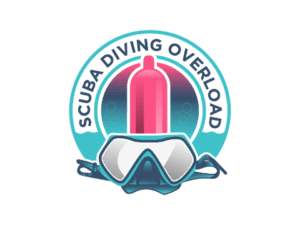In Section 3 of PADI’s Open Water Diver eLearning (Chapter 3 of the Open Water Diver Manual), you have learnt some important concepts about being a diver, equipment handling, scuba diving and problem management skills.
The knowledge review section at the end of the third Chapter of the Open Water Diver Manual (or eLearning section 3) will test your knowledge about the dive environment and conditions, assessing diving conditions, managing problems at surface and underwater, safety signalling devices and how to use them, and different water entries.
Being knowledgeable with those concepts will help you become a good diver and get you ready for the open water diver “in-water” sessions.
In case you get some of the answers wrong, you should not worry. The important thing is that you discuss all the answers you do not fully understand with your dive instructor.
If you are looking for explanations to other PADI Open Water knowledge review sections, check out the following links:
- PADI OWD Section 1 Knowledge Review Answers Explained
- PADI OWD Section 2 Knowledge Review Answers Explained
- PADI OWD Section 4 Knowledge Review Answers Explained
- PADI OWD Section 5 Knowledge Review Answers Explained
- PADI Open Water RDP Knowledge Review
- How to Use PADI Dive Tables
One way to avoid disorientation while descending and ascending is to
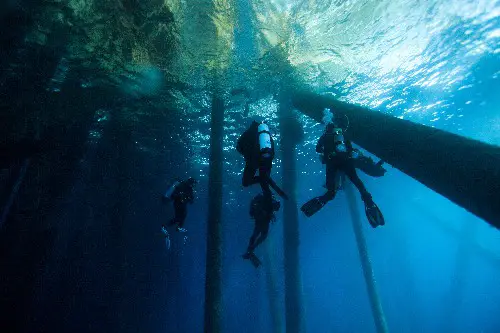
Answer: Follow a reference
The answer to question one seems quite intuitive. Just like when you are hiking, it is important to take reference points in scuba diving as well.
In such a way you can avoid disorientation. Good reference points in scuba diving could be a descent/ascent line, a special rock or coral formation or a wreck.
I strongly recommend avoiding reference points that can move or change with time. For example, it could be very tempting to take a red frog fish as a reference point, in the end they can be still in the same point for weeks.
However, if another diver would disturb such frog fish during your dive, you can bet it will move and no longer be useful as a reference point.
Diving tip: before taking a reference point while scuba diving, make sure it is a “still point” with zero chances to move.
My buddy and I are diving from a boat and there’s a mild current. In most circumstances, we would ___________ for the first part of the dive.
Answer: Swim into the Current
The key to answer correctly this question is to focus on the word “mild”. In case of mild currents, you would swim into the current for the first part of a dive and swim with the current on the way back.
As long as swimming into the current is manageable, this ensures that you will not go too fast and end your dive far away from the dive site.
Diving tip: the best judge of whether a current is mild or not is you. If you feel a current is too strong, signal it to your guide or divemaster and avoid swimming against the current if you feel you are overexerting.
My buddy and I get disoriented while boat diving. There is a mild current, and we surface away from the boat. We should ___________.
If unable to reach the boat or too tired, we should _____________.
Answer: Swim into the current to reach the trail line, become buoyant and signal the boat to pick us up.
If you realize you have surfaced far away from the diving boat, the first thing you should do is to make sure you are positively buoyant. This will ensure you are more visible and prevent you from drowning in case you get excessively tired.
There is virtually no reason for which you should re-immerge yourself and try to reach the dive boat below the surface. Besides being dangerous as you would be skipping the surface interval, you would not see the boat in case it moves.
If the current at surface allows you to do so, you should swim towards the trail line (even if against the current).
In case you are feeling overly tired or feel that you would not manage to reach the trail line, you should signal the dive boat to pick you up.
You can signal the boat to pick you up either by using an audible signalling device such as a whistle or a visual signalling device such as a delayed surface marker buoy.
Diving tip: whether you are a newly certified or a seasoned diver, you should always carry with you an audible and a visual signalling device. To know more, check my articles on Five Accessories Every Scuba Diver Should Have and on How to Choose the Right Delayed Surface Marker Buoy.
My buddy and I remain neutrally buoyant and stay above the bottom enough to avoid contact. We do this because bottom contact (choose all that apply)
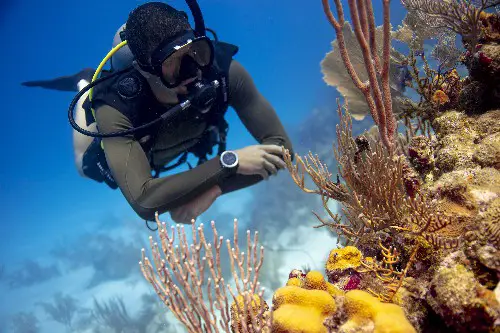
Answer: May injure or kill aquatic life, tends to disturb the bottom and reduce visibility, increase the risk of accidental cuts, scrapes or stings.
One of the fundamental skills in scuba diving is to maintain neutral buoyancy. This will allow you to choose and calibrate your diving depth and will help you avoiding touching the bottom.
Touching the bottom while diving can be harmful both for aquatic life and for yourself.
When it comes to aquatic life for example, both soft and hard corals can break quire easily, and it would take them years to re-grow.
Besides, some corals can also be poisonous (think of fire coral) or sharp and could hurt or cut yourself or your scuba equipment.
Diving tip: whenever you start a dive, make sure all your equipment (such as your octopus or SPG) is perfectly in place and tucked in your BCD. This will help preventing hurting or damaging marine life.
When assessing conditions, if there is anything that causes me significant anxiety or concern, if I can’t address it, I should not dive. Ultimately, I am responsible for my own safety, so only I can make the final decision.
Answer: True
In recreational scuba diving, there are relatively few fundamental rules. It is essential that you follow them to dive safely and enjoy the most.
Rule number one is that you should never hold your breath. You have already learned in Section 1 why holding your breath while scuba diving is extremely dangerous.
The second most important rule in scuba diving is that you are ultimately responsible for starting or ending a dive. If you suddenly do not feel like diving, whatever the reason, you should not start a dive.
Diving Tip: Never be afraid to call off a dive. You are the ultimate responsible for your own safety and if you do not feel like diving there is no reason to force yourself. Your buddy can be paired up with other divers quite easily so you shouldn’t be afraid of leaving her alone.
When planning to dive in an environment that is new to me, it is recommended that I get a local orientation from an experienced diver or professional who knows the procedures, hazards, points of interest and other factors unique to the environment.
Answer: True
A local orientation dive is always a good option, particularly if it is your first time in a dive site.
Even if a dive site might look pristine, you never know if there can be some hidden dangers that are not visible from the surface or by snorkelling.
Some examples include sudden currents, harmful marine life such as fire coral, or even high and low tides.
Diving Tip: Whenever you dive in a new dive site, try to have the first dive with a local guide. This will prevent you from finding yourself in dangerous situations.
Risks of diving beyond my training and experience limits include that (choose all that apply)
Answer: In some forms of diving, the hazards are not obvious, it can cause me to have a false sense of security, anxiety from doing so can distract me from noticing other problems.
Diving beyond you’re your training qualifications and experience can be fatal and should always be avoided.
You might go against some dangers that are not obvious (for example oxygen toxicity while diving with Nitrox), can cause you a false sense of security in case every goes fine at the first try, and it can also distract you from noticing other problems.
While planning a shore dive, my dive buddy says it will be “no problem” diving in high surf that I’ve never been trained in nor have experience with. Looking at the surf, I don’t think I am prepared for diving in it. My best response is to
Answer: Politely refuse to dive and suggest an alternate location with no significant surf.
As discussed in question 5, one of the fundamental rules in scuba diving is that you are the ultimate responsible of your own safety. If you do not feel like starting a dive, you should not be afraid to call it off.
Some diving situations require special training, and it is never a good idea to do some diving that goes beyond your training qualifications.
To prevent and/or handle injuries caused by aquatic life, I should (choose all that apply)
Answer: Watch where I put my feet, hands, and knees; wear an exposure suit, treat all organisms with respect; be familiar with potentially hazardous animals where I am diving; be prepared first aid for aquatic life injuries.
The answers to these questions are quite intuitive. I just like to expand a little bit more on wearing an exposure suit.
As a scuba diving instructor, I always get questions on diving without a wetsuit. And I never recommend to do so.
A wetsuit does not only protect you from cold, but it also protects you from some forms of marine life that are possibly harmful.
Think for example of some jellyfish, fire corals, or even some micro plankton. Depending on your diving location you may want to choose different different wetsuit thicknesses, but wearing one is a no brainer.
My buddy and I accidentally find ourselves in a rip current. There are no special, local procedures, so we follow the generally recommended action of
Answer: Inflating our BCD and swimming parallel to shore.
Swimming against a rip current is never a good idea. You might have the impression that you will make it to the shore but will soon find yourself exhausted and without much energy to swim further.
This is why it is essential to establish positive buoyancy by inflating your BCD, and swim parallel to the shore until current conditions have changed.
Rip currents are generally a localized phenomenon and by swimming parallel to shore you will find another place with easy access to the beach.
Diving tip: assessing distances while on the surface can be somewhat misleading. Under certain conditions, the shore might look closer than it actually is. This is why it is never a good idea to swim against a rip current to reach the shore.
Depending upon my location, tides can cause significant changes to depth, currents and visibility, or they may have hardly any effect.
Answer: True
As you have learnt in your theory, tides depend on the gravitational forces between the earth, the moon, and the sun.
The side of the Earth closest to the Moon will be affected the most by its gravitational pull and as a consequence you will have stronger tides.
In some other areas of the Earth, tides can almost be imperceptible with little effects on depth, currents, or visibility.
Before starting a dive, you should always get acquainted with local tides and how they might affect water depth, visibility, and currents.
When boarding a dive boat, the divemaster asks me to fill my name in on the roll. The reason for this is to
Answer: Make sure everyone is aboard after each dive.
Whenever boarding a dive boat, the dive master or boat crew will always ask you to fill your name in the roll.
This is to make sure that everyone has returned on board after a dive and that it is safe to turn on the boat’s engines.
The best entry is usually the
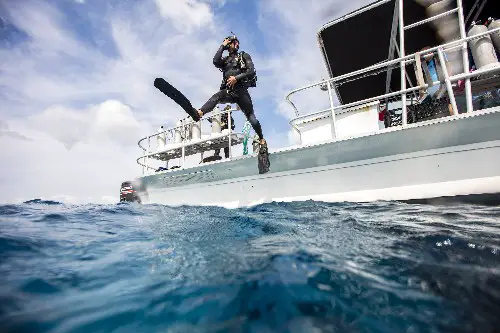
Answer: Easiest one.
You might have learnt different types of entries such as the giant stride or the back roll, however you should always remember that the best entry is usually the easiest one.
If you are diving from a zodiac, most likely the best option will be the backroll. However if you are diving from a Maldivian Dhoni, the best entry will most likely be a giant stride.
I should stay well away from the boat propeller at all times, even when the engine isn’t running.
Answer: True
As you have learnt in chapter three of your open water diver manual, scuba diving is also about risk management and prevention.
There is no better way to prevent an injury from boat propellers than to stay away from them at any time.
My buddy and I are diving from a boat in mild to moderate current. There is a line from the back of the boat where we’ll enter, which leads to the mooring line at the front of the boat. The purpose of the line leading to the mooring line is to
Answer: Let us pull ourselves to the mooring line.
Depending on the conditions of local currents, it is not uncommon to have some ropes around a diving boat that lead to the mooring line.
In such a way you can safely and effortlessly reach the mooring line and eventually use it as a reference point for your descent and ascent.
In case of moderate currents, upon surfacing from a dive, the line connecting the back of a boat to the mooring line can also be useful to avoid being carried over by the current.
My buddy and I surface and the boat is not in sight, nor is there a float and we are beyond sight of shore. We should inflate our BCDs, deploy our surface signaling devices and stay together.
Answer: True
The fundamental part of this question that you should retain is that you should always be together with your buddy, even once at the surface.
Diving Tip: Never separate from your buddy at surface. A buddy can support you also at surface by helping you inflate your BCD, or by checking on you if you are not feeling well.
Training that expands and develops my skills in preventing and managing problems include: (choose all that apply)
Answer: PADI Rescue Diver, PADI Emergency Oxygen Provider, Emergency First Response Primary and Secondary Care Course.
In all those courses you will learn how to manage different emergency situations, from how to rescue a missing diver to how to administer emergency oxygen.
I can only recommend all such courses from PADI, they will definitely improve your diving and risk management skills.
At the surface, I have a problem. If I have not already done so, the first thing I should do is
Answer: Make myself buoyant (inflate my BCD and/or drop weights).
Whenever you are at the surface, it is always a good practice to establish positive buoyancy.
This should be always done, irrespectively of whether you are experiencing a problem or not.
Diving Tip: Establishing positive buoyancy at the surface will help you avoid overexertion and fatigue.
A diver at the surface begins to struggle. He has wide, unseeing eyes and he has pushed off his mask. His BCD isn’t inflated and he doesn’t inflate it when the divemaster calls for him to do so. This diver is _______________. To help, I should first ______________.
Answer: Out of Control, Make Myself and the Diver Buoyant
Whenever you see a diver is out of control and not responding properly to oral commands, your priority should be your own safety.
This is why you should establish positive buoyancy for yourself first.
Subsequently, once you have assessed it is safe to do so, you should make the other diver buoyant by inflating her BCD.
With an unresponsive diver underwater, the primary concern is ______________________. Once at the surface, besides establishing buoyancy and calling for help, the primary concern is ______________________.
Answer: Getting the victim to the surface, checking for breathing and providing rescue breaths if the victim isn’t breathing.
In case of unresponsive diver underwater, your first priority should be to bring such diver in a condition to be rescued: to the surface.
Once you have brought the diver to the surface, you should establish positive buoyancy, call for help, and check whether the diver is breathing before starting rescue breaths.
Diving Tip: Whenever you find yourself in a rescue situation, your first concern should be your personal safety. All rescue operations should be conducted in a way that they do not undermine your personal safety.
While diving, I begin to feel exhausted and air-starved because I have been swimming strenuously. I should
Answer: Signal “stop” and rest.
There are several reasons for which you might find yourself exhausted during a dive. For example, you might have been swimming against a current, or are overweighted.
Whatever the reason, the very moment you find yourself exhausted and air-starved, you should signal it to your buddy, stop, and rest for a while.
This will help you recover, and bring your heart rate back to normal before continuing the dive or ascending.
Diving Tip: Diving with an accelerated heart rate because of exhaustion can literally double your gas consumption. If you experience exhaustion, the most immediate solution is to rest and wait for your heartbeat to return to normal.
In helping an unresponsive diver, after you check for breathing and provide CPR as needed (once out of the water), which of the following has the highest priority?
Answer: Contact emergency medical care.
After having rescued a diver and provided CPR, you should contact emergency professionals that can take over the situation from you and eventually bring the diver to an emergency facility.
Bear in mind that providing CPR can be life saving for the victim but exhausting for the rescuer. Besides, in some situations, CPR can only be the first part of the solution to a medical condition.
This is why it is essential to contact emergency professionals.
Although it shouldn’t have happened, on a dive at 10 metres/30 feet, I fail to watch my SPG and run out of air. I don’t have a pony bottle or self-contained ascent bottle. My buddy is about 12 metres/40 feet away, and has an alternate second stage. My best option is probably to
Answer: Make a Controlled Emergency Swimming Ascent
You will practice the Controlled Emergency Swimming Ascent several times in your open water diving course.
This is one of the most essential emergency procedures in scuba diving at shallow depths.
It is also one of the procedures you will never need to follow if you dive close to your buddy.
Do not forget: having emergency gas from a buddy is still safer than ascending to the surface, even if in a controlled manner.
Any diver who has been unresponsive in or under water requires medical examination, even if the person seems fully recovered.
Answer: True
Any diver who has been unresponsive either at the surface or underwater, needs to undergo medical examination even if at first sight she seems fully recovered.
Unresponsiveness could be the result of a medical condition that can only be checked by a qualified doctor.
At a minimum, I should have ____ visual and ____ audible signaling devices.
Answer: 1, 1
Signalling devices should be part of every diver’s equipment. This is why I have inserted both an audible and a visible signalling device in my list of Five Scuba Diving Accessories Every Diver Should Have.
Audible signalling devices such as a whistle as well as visible ones such as a DSMB occupy very little space and do not add additional weight to your diving equipment.
My buddy and I are underwater within 6 metres/20 feet of our float with a locally-recognized dive flag. We hear a boat, and it sounds close and is getting closer.
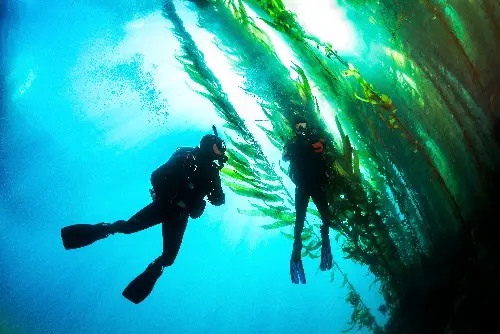
Answer: We should stay deep enough to be safe. The boater may not see or recognize the flag.
As a diver you should always assess and minimize possible risks. Never taking for granted other people’s knowledge is part of minimizing risks.
If you hear a boat close to you, descend to a safe depth until the boat appears further away. It is always a good option to deploy a DSMB to make yourself more visible at the surface.
